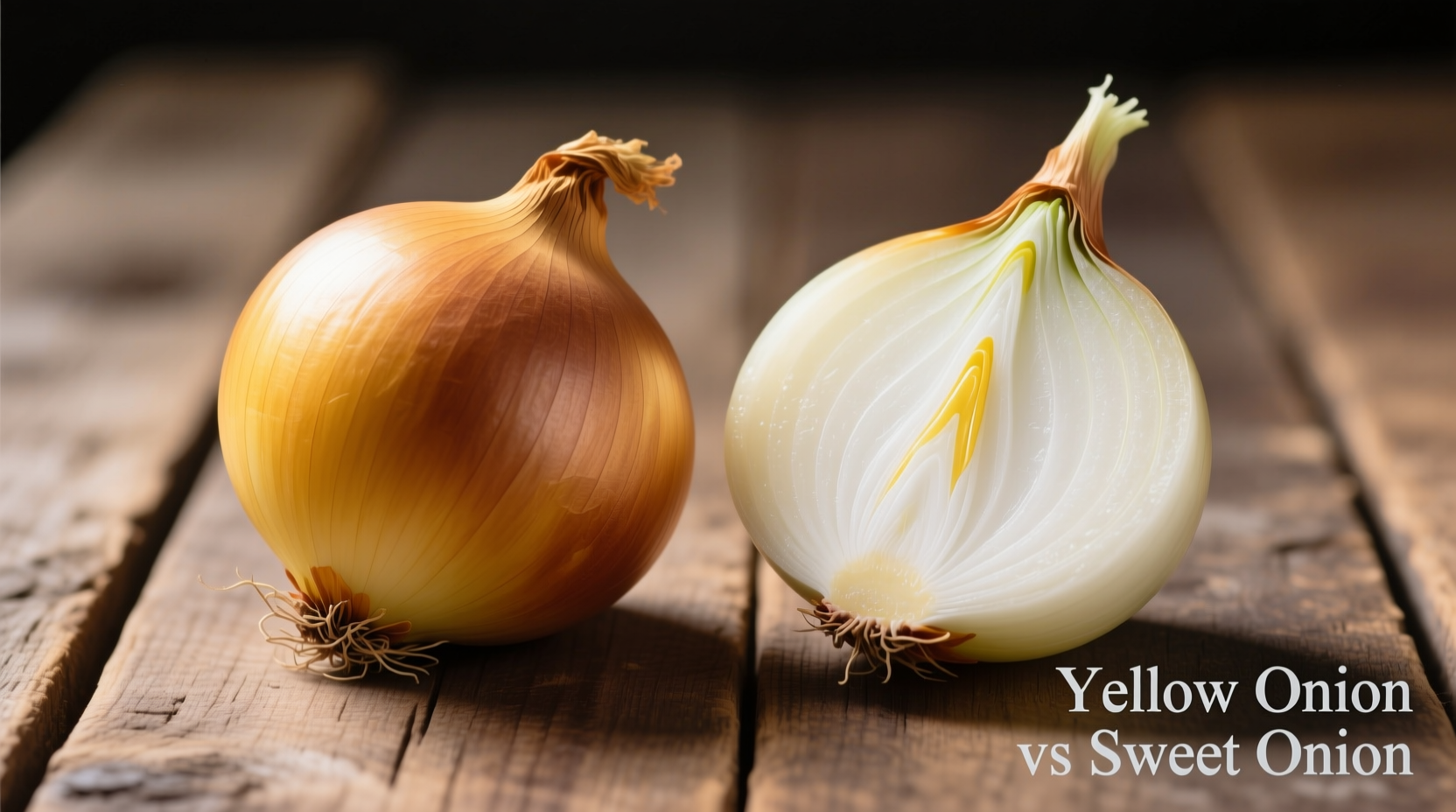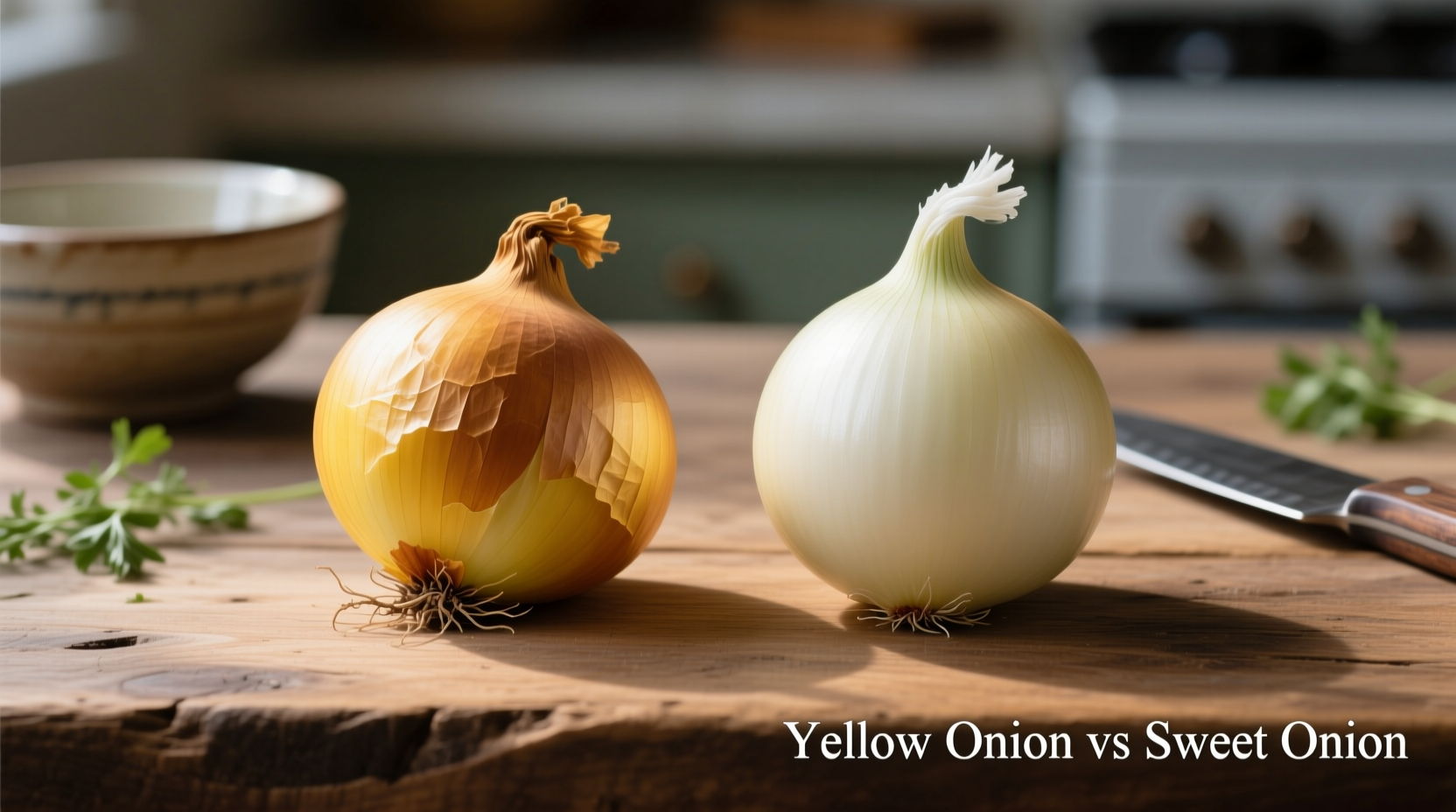Understanding Onion Varieties: What Sets Yellow and Sweet Onions Apart
When you're standing in the produce section deciding between yellow onions and sweet onions, you're facing a fundamental culinary choice that impacts your dish's entire flavor profile. This isn't just about personal preference—it's about understanding how each variety's chemical composition affects your cooking results.
According to the USDA Agricultural Research Service, the key difference lies in sulfur compounds. Yellow onions contain higher levels of these compounds, which create that characteristic sharp bite when raw but transform into rich, sweet caramelized notes when cooked. Sweet onions, by contrast, have been specifically cultivated to have lower sulfur content and higher sugar levels—typically 4-6% more natural sugars than yellow varieties.

Flavor Chemistry in Action: How Each Onion Behaves
Your cooking success depends on understanding how these onions transform during preparation. When you slice a yellow onion, you release enzymes that create volatile sulfur compounds—those are what make you cry. But when you apply heat, these compounds break down into sweet, complex flavor molecules through the Maillard reaction.
Sweet onions behave differently. With their lower sulfur content, they don't develop the same depth of flavor when cooked for extended periods. Culinary chemist Dr. Harold McGee explains in On Food and Cooking that sweet onions' delicate flavor compounds can break down too quickly with prolonged cooking, resulting in a less complex final product.
| Characteristic | Yellow Onion | Sweet Onion |
|---|---|---|
| Water Content | 89% | 90-92% |
| Sugar Content | 4-5% | 8-12% |
| Sulfur Compounds | High | Low |
| Best Storage | 3-4 months in cool, dark place | 2-3 weeks refrigerated |
When to Choose Yellow Onions for Maximum Flavor Impact
Professional chefs reach for yellow onions in approximately 80% of cooked applications according to a Culinary Institute of America survey. Their versatility makes them indispensable for:
- Soup and sauce bases - Their robust flavor forms the essential foundation for stocks, gravies, and braises
- Caramelization projects - Yellow onions develop deeper, more complex sweet notes when slowly cooked
- Roasted vegetable medleys - They hold their structure better than sweet varieties during extended cooking
- Onion rings - Their firmer texture creates a superior crunch when battered and fried
The University of California Agriculture and Natural Resources notes that yellow onions contain quercetin, a flavonoid antioxidant that becomes more bioavailable when cooked—a nutritional advantage over raw consumption.
Sweet Onion Applications: Where Their Delicate Flavor Shines
Sweet onions aren't just for eating raw—they have specific culinary strengths that yellow onions can't match:
- Grilled preparations - Their higher sugar content creates beautiful caramelization without bitterness
- Fresh salsas and pico de gallo - They provide onion flavor without overwhelming other ingredients
- Ceviche and crudo - Their mildness complements delicate raw fish preparations
- Onion salads - Try thinly sliced sweet onions with citrus vinaigrette for a refreshing side
It's important to note that not all sweet onions are created equal. True sweet onion varieties like Vidalia (Georgia), Walla Walla (Washington), and Maui (Hawaii) are grown in specific low-sulfur soil regions that give them their distinctive mildness. Generic "sweet onion" labels at supermarkets often refer to milder yellow varieties rather than true regional specialties.
Smart Substitution Strategies for Your Kitchen
Running out of one variety doesn't mean scrapping your recipe. Follow these professional substitution guidelines:
- Using yellow instead of sweet - Soak sliced yellow onions in cold water for 10 minutes to reduce sharpness for raw applications
- Using sweet instead of yellow - Add a pinch of ascorbic acid (vitamin C powder) to compensate for lower sulfur compounds in cooked dishes
- For French onion soup - Use 75% yellow onions and 25% sweet onions for optimal flavor balance
- When making marmalade - Sweet onions require 25% less sugar than yellow varieties to achieve proper consistency
Food scientist Dr. Ali Bouzari emphasizes in Ingredient that understanding these substitution principles prevents recipe failures. "The difference between a balanced dish and an onion disaster often comes down to selecting the right allium variety for your cooking method," he notes.
Storage Secrets for Maximum Freshness
Proper storage dramatically affects both varieties' performance in your kitchen:
- Yellow onions - Store in a cool, dark, well-ventilated space (55-60°F). Never refrigerate whole bulbs as moisture promotes spoilage
- Sweet onions - Require refrigeration due to higher water content. Store in the crisper drawer in a mesh bag for optimal airflow
- Pre-cut onions - Both varieties should be stored in airtight containers in the refrigerator for no more than 7 days
- Freezing tip - Freeze diced onions on a baking sheet before transferring to containers to prevent clumping
The National Onion Association reports that improper storage accounts for nearly 30% of home cooking onion failures. Their research shows that yellow onions stored at room temperature maintain flavor compounds better than refrigerated ones, while sweet onions deteriorate 40% faster at room temperature.
Nutritional Comparison: Health Benefits Beyond Flavor
Both varieties offer significant health benefits, but with some important distinctions:
- Quercetin content - Yellow onions contain up to 11 times more quercetin, a powerful antioxidant linked to reduced inflammation
- Vitamin C - Sweet onions provide approximately 15% more vitamin C per serving
- Caloric density - Sweet onions have slightly more natural sugars (about 5 more calories per 100g)
- Prebiotic fiber - Both contain inulin, but yellow onions have higher concentrations that support gut health
Research published in the Journal of Agricultural and Food Chemistry confirms that cooking yellow onions increases the bioavailability of their beneficial compounds, while sweet onions' nutritional advantages are best preserved when eaten raw.
Professional Chef Tips for Perfect Onion Results Every Time
Implement these techniques used in professional kitchens:
- Cutting direction matters - Cut across the grain (perpendicular to growth rings) for milder raw applications, with the grain for cooking
- Temperature control - Start caramelizing onions in cold oil to prevent burning and ensure even cooking
- Salt timing - Add salt after 5 minutes of cooking to prevent excess moisture release during caramelization
- Acid balance - A splash of vinegar or citrus juice at the end of cooking brightens both varieties' flavors
Remember that onion strength varies by season—spring and summer onions generally have milder flavor than fall-harvested varieties regardless of type. This seasonal variation explains why your favorite recipe might taste different at various times of year.











 浙公网安备
33010002000092号
浙公网安备
33010002000092号 浙B2-20120091-4
浙B2-20120091-4